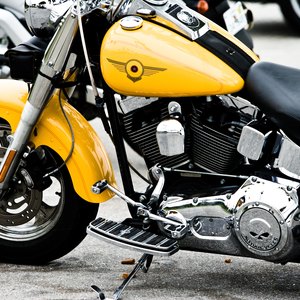
Depreciation is a tax measurement of how much value an asset loses over time. The Internal Revenue Service allows taxpayers to deduct depreciation on vehicles used for business purposes, including motorcycles. Most of the time, deductions for a motorcycle or other business vehicles are figured using standard IRS rules based on time and mileage. Depreciation is not the same as a motorcycle's resale value, which can vary depending upon the its make and model.
Listed Property
Most depreciation is reported using the IRS's standard Modified Accelerated Cost Recovery System (MACRS). The MACRS system lays out the "class life" of certain assets, which is how long the IRS considers the asset useful for business purposes. Vehicles used for business, including motorcycles, have a class life of 5 years. Like other vehicles, the IRS classifies motorcycles as "listed property", which means a taxpayer can only claim depreciation expenses if it is used at least 50 percent of the time for business purposes. Taxpayers will have to keep records of the motorcycles use, including mileage.
Straight Line Depreciation
MACRS uses a "straight line" method of depreciation, which spreads the deduction out evenly over each year, after taking into account any non-business use and its resale value. For example, if a courier agency bought a motorcycle for $2,200 that it could resell for parts for $200 after 5 years, then the agency could deduct $400 in businesses expenses each year for the motorcycle. If only 50 percent of the motorcycle's mileage was for business, then the business could deduct only $200 in depreciation. There are also other methods of calculating depreciation of vehicle, including the Alternative Depreciation System, which lets business owners calculate depreciation at varying percentages each year.
Resale Value
Depreciation is different from resale value, which takes into account the quality and utility of the vehicle. A motorcycle make and model that is rare or that is renowned for its durability may command a higher resale price than the everyday motorcycle that's going to need regular maintenance. Some automotive information services, including the Kelley Blue Book and NADA guides, list the resale values of nearly all vehicles' makes, models and years. However, these guidebooks don't fully take into account the motorcycle's condition or the local market.
Motorcycle Condition
Motorcycle owners who want to calculate their bike's resale value will need to honestly rate its condition. A used motorcycle can rate from excellent, for a showroom-ready bike, to very good, with minimal wear, to good condition, for motorcycles with a little wear and some slight mechanical issues. Motorcycles are in fair condition if there is cosmetic damage, but operational, and poor conditioned bikes may not operate properly or have major mechanical or cosmetic damage. By researching used motorcycle listings in national and local publications, including local classified and auto listings, owners can find a price range for their motorcycle's resale value.
References
- Internal Revenue Service: Publication 946 - How to Depreciate Property
- Internal Revenue Service: Depreciation Frequently Asked Questions
- National Timber Tax Website: Depreciation
- Esurance. "Motorcycle Theft: Facts, Stats, and Prevention." Accessed April 5, 2020.
- National Insurance Crime Bureau. "FBI Releases New Auto Theft Numbers — Nearly 750,000 Motor Vehicles Stolen in 2018." Accessed April 5, 2020.
- National Insurance Crime Bureau. "2018 US Motorcycle Theft and Recovery," Page 1. Accessed April 5, 2020.
- Progressive. "Motorcycle Insurance 101." Accessed April 5, 2020.
- Farmers Insurance. "Does Motorcycle Insurance Cover Theft?" Accessed April 5, 2020.
- Progressive. "Motorcycle Claims." Accessed April 5, 2020.
- California Department of Insurance. "Fair Claims Settlement Practices Regulations." Accessed April 5, 2020.
- Progressive. "Total Loss." Accessed April 5, 2020.
- Nationwide. "What Does Motorcycle Insurance Cover?" Accessed April 5, 2020.
- Allstate. "What Do Collision And Comprehensive Motorcycle Insurance Cover?" Accessed April 5, 2020.
- Pemco Insurance. "Understanding Total Loss Claims." Accessed April 5, 2020.
Writer Bio
Terry Lane has been a journalist and writer since 1997. He has both covered, and worked for, members of Congress and has helped legislators and executives publish op-eds in the “Wall Street Journal,” “National Journal” and “Politico." He earned a Bachelor of Science in journalism from the University of Florida.

